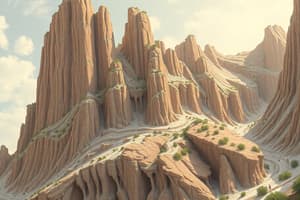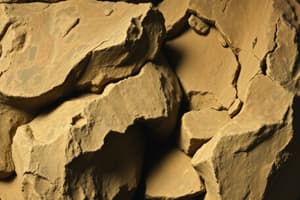Podcast
Questions and Answers
What primarily determines whether a rock will undergo ductile or brittle deformation?
What primarily determines whether a rock will undergo ductile or brittle deformation?
- The age of the rock and its geological history
- The temperature and pressure conditions at depth (correct)
- The mineral composition and strength of the rock
- The time over which forces are applied (correct)
At what depth is ductile deformation more likely to occur?
At what depth is ductile deformation more likely to occur?
- At any depth depending on the mineral composition
- At medium depths with moderate pressure
- At great depths where temperature and pressure are higher (correct)
- At shallow depths where rocks are cooler
Which type of rocks is favored for brittle behavior?
Which type of rocks is favored for brittle behavior?
- Igneous rocks such as granite and basalt (correct)
- Sedimentary rocks with a high clay content
- Metamorphic rocks with strong internal bonds
- Nonsilicate rich rocks like shale
What characterizes a monocline?
What characterizes a monocline?
Which statement is true regarding the application of force on rocks?
Which statement is true regarding the application of force on rocks?
In terms of geological formations, what distinguishes a dome from a basin?
In terms of geological formations, what distinguishes a dome from a basin?
What is the first step in mapping rock structure?
What is the first step in mapping rock structure?
Which type of fault is defined by movement parallel to the dip of the fault surface?
Which type of fault is defined by movement parallel to the dip of the fault surface?
What is the distinction between a normal fault and a reverse fault?
What is the distinction between a normal fault and a reverse fault?
What occurs in subduction zones?
What occurs in subduction zones?
What characterizes a reverse fault?
What characterizes a reverse fault?
What geological feature results from two normal faults?
What geological feature results from two normal faults?
Which of the following is true regarding normal faults?
Which of the following is true regarding normal faults?
Which statement accurately describes a fault scarp?
Which statement accurately describes a fault scarp?
In which settings can normal faults commonly be found?
In which settings can normal faults commonly be found?
What type of fault involves horizontal movement with no vertical displacement?
What type of fault involves horizontal movement with no vertical displacement?
Which process leads to the formation of columnar joints in igneous rock?
Which process leads to the formation of columnar joints in igneous rock?
How do joints enhance the process of chemical weathering?
How do joints enhance the process of chemical weathering?
What is a significant consequence of seepage along joints in a dam structure?
What is a significant consequence of seepage along joints in a dam structure?
Which of the following best describes the formation of exfoliation domes?
Which of the following best describes the formation of exfoliation domes?
What is the relationship between strike and dip in geological formations?
What is the relationship between strike and dip in geological formations?
In a geologic map, the strike reported as N60oE indicates what?
In a geologic map, the strike reported as N60oE indicates what?
What characterizes an anticline in geological terms?
What characterizes an anticline in geological terms?
Which of the following describes a syncline?
Which of the following describes a syncline?
What defines a plunging anticline?
What defines a plunging anticline?
What is the primary force responsible for the formation of anticlines and synclines?
What is the primary force responsible for the formation of anticlines and synclines?
Which part of a folded rock refers to the imaginary surface that divides the fold as symmetrically as possible?
Which part of a folded rock refers to the imaginary surface that divides the fold as symmetrically as possible?
What features differentiate symmetrical anticlines from asymmetrical ones?
What features differentiate symmetrical anticlines from asymmetrical ones?
What is the main focus of structural geology?
What is the main focus of structural geology?
Which type of stress occurs when forces push rock together and reduce its volume?
Which type of stress occurs when forces push rock together and reduce its volume?
What happens to a rock experiencing elastic deformation when the stress is released?
What happens to a rock experiencing elastic deformation when the stress is released?
Which type of fault is characterized by the rock above the fault plane moving down relative to the rock below?
Which type of fault is characterized by the rock above the fault plane moving down relative to the rock below?
How does the orientation of folds and faults contribute to economic geology?
How does the orientation of folds and faults contribute to economic geology?
What type of deformation occurs when a rock bends or flows without breaking?
What type of deformation occurs when a rock bends or flows without breaking?
What is the term for the amount of force acting on the rock causing deformation?
What is the term for the amount of force acting on the rock causing deformation?
Which of the following describes shear stress?
Which of the following describes shear stress?
Flashcards
Stress
Stress
The amount of force acting on a rock.
Strain
Strain
The change in shape or volume of a rock due to stress.
Compressional Stress
Compressional Stress
Forces push rocks together, shortening the rock.
Tensional Stress
Tensional Stress
Signup and view all the flashcards
Shear Stress
Shear Stress
Signup and view all the flashcards
Elastic Deformation
Elastic Deformation
Signup and view all the flashcards
Ductile Deformation
Ductile Deformation
Signup and view all the flashcards
Brittle Deformation
Brittle Deformation
Signup and view all the flashcards
Depth's Influence on Deformation
Depth's Influence on Deformation
Signup and view all the flashcards
Rock Type and Deformation
Rock Type and Deformation
Signup and view all the flashcards
Time and Deformation
Time and Deformation
Signup and view all the flashcards
What is an Outcrop?
What is an Outcrop?
Signup and view all the flashcards
How to Map Rock Structure
How to Map Rock Structure
Signup and view all the flashcards
Dip
Dip
Signup and view all the flashcards
Geologic Map
Geologic Map
Signup and view all the flashcards
Limb (of a fold)
Limb (of a fold)
Signup and view all the flashcards
Hinge Line (Axis)
Hinge Line (Axis)
Signup and view all the flashcards
Axial Plane
Axial Plane
Signup and view all the flashcards
Plunge (of a fold)
Plunge (of a fold)
Signup and view all the flashcards
Hogback
Hogback
Signup and view all the flashcards
Hanging Wall
Hanging Wall
Signup and view all the flashcards
Foot Wall
Foot Wall
Signup and view all the flashcards
Reverse Fault
Reverse Fault
Signup and view all the flashcards
Normal Fault
Normal Fault
Signup and view all the flashcards
Fault Scarp
Fault Scarp
Signup and view all the flashcards
What are subduction zones?
What are subduction zones?
Signup and view all the flashcards
What is a plunging fold?
What is a plunging fold?
Signup and view all the flashcards
What is an axial trace?
What is an axial trace?
Signup and view all the flashcards
What is a monocline?
What is a monocline?
Signup and view all the flashcards
What are domes and basins?
What are domes and basins?
Signup and view all the flashcards
Basin and Range Province
Basin and Range Province
Signup and view all the flashcards
Strike-Slip Fault
Strike-Slip Fault
Signup and view all the flashcards
Joint
Joint
Signup and view all the flashcards
Columnar Joints
Columnar Joints
Signup and view all the flashcards
Study Notes
Chapter 10: Deformation of Rocks
- Rocks deform in response to stress, resulting in folding, flowing, and fracturing.
- Folds and faults are geologic structures.
- Structural geology studies the deformation of rocks.
- Stress is the amount of force acting on a rock (tectonic forces).
- Strain is the shape or volume changes caused by stress (deformation).
Types of Differential Stress
- Compressional stress: Forces push rocks together, shortening the rock body and reducing its volume.
- Tensional stress (extensional stress): Forces pull rocks apart, elongating the rock body.
- Shear stress: Forces push rocks toward each other but parallel to one another.
Types of Deformation
- Elastic deformation: A temporary change in shape in response to stress. The rock returns to its original shape when the stress is released.
- Ductile deformation: The rock bends or flows, changing its shape without breaking. This change is permanent.
- Brittle deformation (brittle failure): The rock fractures and breaks into separate pieces. This change is permanent.
Factors Affecting Ductile or Brittle Deformation
- Depth: At shallower depths, rocks are cooler and under lower pressure, favoring brittle deformation. Deeper, hotter rocks under high pressure favor ductile deformation.
- Rock type: Silicate-rich rocks (e.g., granite, basalt) tend to be brittle, while non-silicate rocks (e.g., shale) are more ductile due to weaker internal bonds.
- Time: Quickly applied forces trigger brittle deformation, while slowly applied forces create ductile deformation.
Mapping Rock Structure
- Locate outcrops (surface exposures of rocks) to identify rock types.
- Measure the strike and dip of folds, faults, and rock layers.
- Plot the strike, dip, and rock type data on a geologic map.
Strike
- A line produced by the intersection of a horizontal plane on a rock surface.
- Determined by the path a ball would take if rolled on the rock surface.
- Reported as an angle relative to north.
Dip
- The angle of inclination of a rock surface from the horizontal plane.
- Perpendicular to the strike, representing the path a ball would roll down a rock face.
- Reported as an angle and a direction (e.g., 30° East).
Parts of a Folded Rock
- Limb: The two sides of the fold.
- Hinge line (axis): A line drawn along the points of maximum curvature of each layer.
- Axial plane: An imaginary surface that divides the fold as symmetrically as possible.
Types of Folds
- Anticline: Arching of geologic layers with older rocks inside the fold.
- Syncline: Trough, downfolded layers with older rocks on the outside of the fold.
- Monocline: A fold with only one limb. Produced by vertical displacement along a fault rather than compression.
- Dome: Circular upwarping; oldest strata within.
- Basin: Circular downwarping; youngest strata within.
Faults
- Faults are fractures with appreciable displacement.
- Dip-slip faults: Movement parallel to the dip of the fault surface, creating vertical displacement.
- Normal fault: Hanging wall moves down relative to the footwall (extensional forces).
- Reverse fault: Hanging wall moves up relative to the footwall (compressional forces).
- Strike-slip fault: Horizontal movement parallel to the strike.
Features of Faulted Terrain
- Horst: Uplifted block bounded by two normal faults.
- Graben: Down-dropped block bounded by two normal faults.
- Fault-block mountains are produced in normally faulted terrain.
Joints
- Joints are fractures with no appreciable displacement.
- Common examples include columnar joints (cooling igneous rocks) and sheeting joints (unloading overlying rock).
- Important because they enhance chemical weathering, influence stream directions,, and can affect construction projects (like dam failures).
Studying That Suits You
Use AI to generate personalized quizzes and flashcards to suit your learning preferences.




